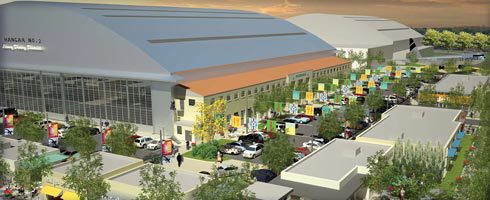Redevelopment of a former military training hangar into a new self-storage facility and development of the surrounding property.
In 1934, the U.S. Army sought a new training site for its growing Army Air Corps and chose Denver as the location for the new facility. Named after 2nd Lt. Francis Lowry, whose plane was shot down during World War I, Lowry Field was used to train thousands of incoming servicemen during World War II. After the war, Lowry Field became Lowry Air Force Base, and President Dwight D. Eisenhower even chose Lowry as the location of his Summer White House from 1952 to 1955.
As part of a national downsizing of the U.S. armed forces in the early 1990s, however, Lowry Air Force Base was decommissioned and closed in 1994. Following its closure, the cities of Denver and Aurora created the Lowry Redevelopment Authority (LRA) to redevelop the base into one of the region’s most innovative new neighborhoods. A national model for base reclamation efforts, the LRA partnered with DURA to use tax increment financing (TIF) to fund environmental remediation efforts and the construction of major infrastructure improvements like the Great Lawn, the crown jewel of Lowry’s park system. Less than two decades later, Lowry is almost completely built out and is now one of Denver’s most successful neighborhoods where more than 25,000 people live, work and play every day.
But at the heart of Lowry, one major redevelopment effort remained undone – preservation of the historic Hangar No. 2. Built in the 1940s as a part of pilot training operations during World War II, the military facility was later placed on the National Register of Historic Structures in recognition of its heritage. One of the earliest buildings in the country to be constructed with steel trusses, the building has an interior span of more than three football fields in area. However, like many historic structures, the building’s greatest assets are also the source of the many challenges associated with trying to redevelop it. More than 15 years after the base closure, the structure still stood empty, awaiting a reuse warranting the significant investment required to modernize the massive structure and bring it up to today’s life safety standards.
In 2009, the team of Larimer Associates and Hartman Ely Investments began working with the community, the Lowry Redevelopment Authority and DURA on a plan to convert the hangar into a self-storage facility and develop the surrounding property into the “Lowry Dining District,” a mix of local restaurants and neighborhood-serving retailers in the heart of Lowry. The first phase of the project rehabilitated the historic structure to its former glory and erected a new building within the historic one. The second phase of the project included renovation of the historic buildings and development of 25,000 square feet of new retail space on the property surrounding the hangar. Completed in 2015, the space and surrounding developments have brought new vitality and investment to the Lowry neighborhood and region.
